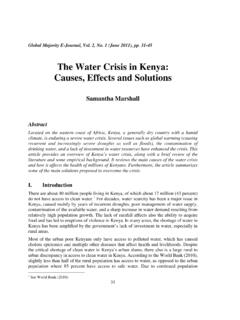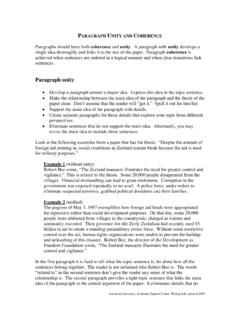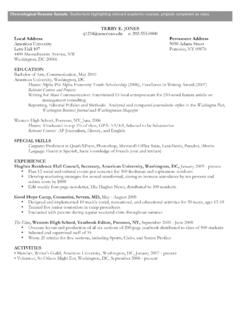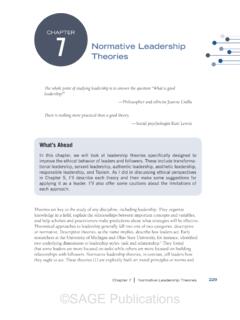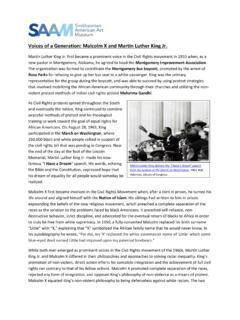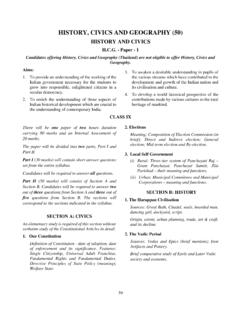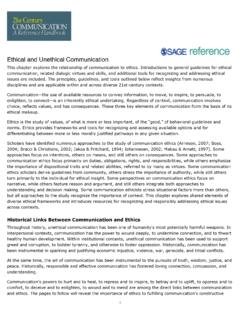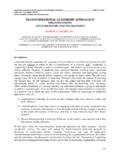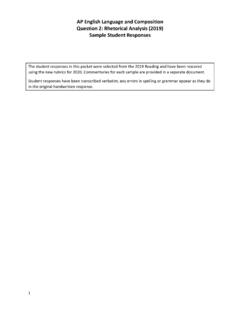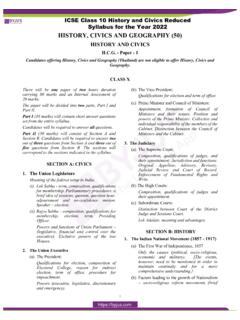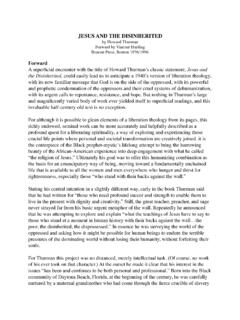Transcription of Ten Steps for Writing Research Papers - American University
1 American University , Academic Support Center, Writing Lab, updated 2009 TEN Steps FOR Writing Research Papers There are ten Steps involved in Writing a Research paper: Step 1: Select a subject Step 2: Narrow the topic Step 3: State the tentative objective (or thesis) Step 4: Form a preliminary bibliography Step 5: Prepare a working outline Step 6: Start taking notes Step 7: Outline the paper Step 8: Write a rough draft Step 9: Edit your paper Step 10: Write the final draft Step 1: Select a subject Choose your subject carefully, keeping in mind the amount of time you have to write the paper, the length of the paper, your intended audience and the limits of the resources. Check in the library to make sure a reasonable amount of information is available on the subject you choose. Writing the paper will be much easier if you select a subject that interests you and that you can form an opinion or viewpoint about.
2 In fact, it will be easier later on to narrow the topic if you choose a subject you already know something about. However, avoid controversial and sensational subjects that are not scholarly, or too technical, or will only restate the Research material. Step 2: Narrow the topic The topic of the paper is what you want to say about the subject. To narrow the topic, you need to read background articles about your subject in encyclopedias and other general references. Do not take notes at this time other than to jot down possible main ideas. As you read, ask questions like the following: Who are the important people involved? What are the major issues? What are my opinions regarding the topic? Why is this an important (controversial, interesting) subject? How has the problem (or issue) developed? When? Where? The answers will help you narrow your topic. Remember to keep in mind the length of your paper.
3 American University , Academic Support Center, Writing Lab, updated 2009 Example of a topic for a five page paper: Too broad: Sports are enjoyable. Better, but still too broad: Swimming is enjoyable. (Answers the question, what sport is enjoyable?) Narrowed topic: Swimming is enjoyable because _____. (Answers the question, why is swimming enjoyable?) Narrowing the topic is a more complicated process for extensive Research . General encyclopedias (like World Book) do not give enough information to get a broad overview of a subject, so instead you need to read specialized encyclopedias, abstracts, etc. At the reference desk in the Bender Library, there are reference guides in business and economics, humanities, history, politics and area studies, and language and literature. Ask the librarian about these and other sources that might be useful to you. When you find the reference books that are available, read only to get an overview of the subject.
4 Step 3: State your objective or thesis Before you begin your Research for your paper, you need to compose a thesis statement that describes the viewpoint you are going to express and support in your paper. Since your purpose in the rest of the paper is to prove the validity of your thesis, your thesis statement provides a controlling idea which will help you choose the resource materials you will use and will limit your note taking. Example: Thesis statement: Ancient Greek culture is reflected in the lives of present day Greeks. Controlling idea: "reflected in." The writer will look for materials that describe characteristics of ancient Grecian culture and characteristics of modern Grecian culture, and for any similarities between the two. A thesis statement must not be an indisputable fact or an opinion that cannot be proven. For example, it would be difficult to write a Research paper to prove the following thesis statements: o The United States was the first nation to land on the moon.
5 [indisputable fact] o Salinger's Catcher in the Rye is the most fascinating novel ever written. [insupportable opinion] American University , Academic Support Center, Writing Lab, updated 2009 Compose your thesis statement carefully, for it is the key to a good paper. As a matter of fact, a good thesis statement can outline your paper for you. For example, the following thesis can be divided into three parts that, in effect, provide a rough outline. Much of Martin luther king 's success resulted from the passive resistance techniques proposed by mahatma gandhi . 1. Martin luther king 's success. 2. The passive resistance techniques of gandhi . 3. The role of gandhi 's passive resistance techniques in Martin luther king 's success. There are several common errors that students make when composing thesis statements. Some of these are listed below, with examples. 1. A thesis cannot be a fragment; it must be expressed in a sentence.
6 Poor: How life is in a racial ghetto. Better: Residents of a racial ghetto tend to have a higher death rate, higher disease rates, and higher psychosis rates than do any other residents of American cities in general. 2. A thesis must not be in the form of a question. (Usually the answer to the question could be the thesis.) Poor: Should eighteen-year-old males have the right to vote? Better: Anyone who is old enough to fight in a war is old enough to vote. 3. A thesis must not contain phrases such as I think. (They merely weaken the statement.) Poor: In my opinion most men wear beards because they are trying to find themselves. Better: The current beard fad may be an attempt on the part of men to emphasize their male identity. 4. A thesis must not contain elements that are not clearly related. Poor: All novelists seek the truth; therefore some novelists are good psychologists.
7 Better: In their attempt to probe human nature, many novelists appear to be good psychologists. 5. A thesis must not be expressed in vague language. American University , Academic Support Center, Writing Lab, updated 2009 Poor: Bad things have resulted from religion being taught in the classroom. Better: Religion as part of the school curriculum should be avoided because it is a highly personal and individual commitment. 6. A thesis must not be expressed in muddled or incoherent language. Poor: In Act One of Othello, to cause them to feel fury against Othello, Iago fuels Brabantio, Othello, Roderigo, and Cassio with deceit by telling them lies. Better: In Act One of Othello, Iago deceives several characters in order to further his plot to destroy Othello's life. 7. A thesis should not be written in figurative language. Poor: Religion is the phoenix bird of civilization. Better: As long as man can conceive the idea of a god, religion will rise to give man a spiritual reason for existence.
8 Step 4: Form a Preliminary Bibliography A preliminary bibliography is a list of potential sources of information. In addition to the card catalog and the guides to reference books already mentioned in Step 2, there are other sources which will help you locate articles and books relevant to your topic. Some of these are listed below: Reference Guides to Indexes and Abstracts Indexes Reader's Guide to Periodical Literature, (1900- ) Business Periodicals Index Social Sciences and Humanities Index, (1965-1974) Humanities Index, ( 1974- ) Social Sciences Index, (1974- ) Bibliographies (available on many subjects) Bibliographic Index: A Cumulative Bibliography of Bibliographies Evaluate the potential sources as you go along, keeping in mind how well they relate to your topic, how up-to-date they are and how available they are. Watch for well-known authors and try to determine the point of view presented in the articles and whether they sound too technical or too simplistic.
9 The following books can help you evaluate sources: Book Review Digest, (1905 - ) American University , Academic Support Center, Writing Lab, updated 2009 Book Review Index, (1965 - ) Index to Book Reviews in the Humanities (1960 - ) As you select articles and books, record information regarding them just as you want it to appear in your bibliography. Using 3x5 index cards is a good method. Later, when you complete your final bibliography, you will just arrange this information in alphabetical order. The form for bibliographic entries varies from school to school. If you are uncertain about which form to use, refer to a writer's handbook, such as A Manual for Writers of Term Papers , Theses, and Dissertations by Kate Turabian, which is available in the University bookstore. Also include the call number for each book and a personal note with each entry. An example of what a bibliographic note card might look like: Tillich, Paul.
10 Systematic Technology. 3 vols. Chicago: University of Chicago Press, 1951-63. (esp. vol. 1, chp. 2) bibliographic information; also see chp. 4 for dissenting opinions Next, gather your materials. Evaluate them again, using the criteria mentioned above. Do this by previewing each source, checking the table of contents and index, finding relevant chapters and skimming them. Step 5: Prepare a Working Outline A working outline is important because it gives order to your notetaking. As you do your Research , you may find that you need to review your plan if you lack information about a topic or have conflicting information. Nevertheless, it provides a good starting point and is essential before you start to take notes. Begin by listing the topics you want to discuss in your paper. (You should have a general idea of these from the reading you have already done.) Then, divide the items on the list into major topics and subtopics.
